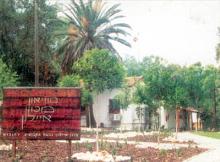| Ayalon Institute - Ta'ass (Military Industry) |
Directions: At "Kiryat Weizmann" for Science Industries junction, on the Rehovot - Ness-Ziona road, is a sign for: "Ayalon Institute Museum." Enter Derech Veissgal all the way to the end, turn right and go up a tree-lined hill. This is 'Givat Kibbutzim.' Further signage leads to the parking lot adjacent to the museum. What's on the hill? The old structures of the kibbutzim (one houses the "Sorek" school) that were once located on the hill can be seen as well as more recent structures. The hill bathes in the trees and vegetation once planted among the structures, and the forests that surround them. For visitors' convenience: Parking lot, picnic areas, drinking fountains and toilets (setting fire is forbidden). One can purchase a "Travel on your own" guide at the office, which includes tours to some of the neighboring sites tied to Rehovot's history: The train station, the first grove, the 'Zofim' (Cub Scouts) forest and the train bridge. Opening Hours: Sunday-Thursday:08:30-16:00; Monday:08:30-18:00 (March - October); Friday: 08:30-12:00; Saturday: 09:00-16:00 A guided tour takes place every hour on the hour, Saturdays and holidays (last tour at 15:00). Group and individual visits and guidance must be booked in advance. Other times can be scheduled with advanced booking. The Ayalon Institute Museum is a reconstructed site of one of the largest Haganah organization military industry factories. The institute was established by Yosef Avidar, the Ta'ass director from 1945, in order to manufacture bullets for the Sten - the personal weapon of Palmach members. The manufacturing process (some of the required machinery was purchased as early as 1938) demanded two conditions: A. A large space for all the machinery, equipment and control measures. B. A place hidden and disguised from the British. The Haganah HQ decided to build an underground institute at 'Givat Hakibbutzim' between Rehovot and Ness-Ziona as a training ground for new settlers' groups prior to their settlement. After the hill was re-organized for accommodating the chosen group of settlers - the 'Zofim' Group A (who later founded Ma'agam Michael), the digging and forging works were completed within 22 days. The institute, designed by engineer Yosef Idelman, was constructed in an 8-meter ditch, was 33 meters long, 8 meters wide, 3.5 meters high, with 0.5- meter wide walls. The entire structure was covered in dirt, leaving two secret entrances. A large baking-oven was placed on top of one of the entrances, and was operated by kibbutz members, who marketed their bread in their area. Atop the second entrance stood a washing machine that also served the area and was operated by kibbutz women. Only the members who worked at the institute knew of its existence. The washing machine noise and the layer of mattresses attached to the bottom of the oven filtered out the machinery noise and enabled the institute to remain a secret, hidden even from some of the kibbutz members who had no part in it. In the summer of 1947, when preparation began for a possible confrontation with the Arabs, the 'Cheftzi-bah' Palmach training was brought to the hill as work reinforcement for the institute. 225 million 9mm bullets were manufactured at the institute under the management of Pesach (Avramovitch) Ayalon, up to the War of Independence. This ammunition was essential for the warriors in the first phase of the war. Until 1963, the hill served as a boarding house for various parties in Israel's defense industry. Later on, the hill was abandoned. Since 1975, different organizations that had a connection to it, became active in the restoration and preservation of the site. In 1986, a public committee was established by the former "Zofim" A member, Shlomo Hillel. Representatives were sent to the committee from the Military Industry, the Haganah Membership Organization, kibbutz Ma'agan-Michael, Rehovot Municipality, the Weizmann Institute of Science, the Jewish National Fund, the Society for Protection of Nature in Israel (SPNI), and the Society for Preservation of Israel Heritage Sites, which took the restoration task upon itself. The museum was opened in 1987 and is operated and maintained by the 'Sorek Field School' members, who settled on the hill. Address: Ayalon Institute Museum - 'Givat Hakibbutzim' Kiryat Hamadah, Rehovot 76326 Tel: 08-9406552 | |||||||||




